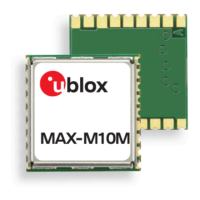
Do you have a question about the Ublox MAX-M10 and is the answer not in the manual?
| Tracking Sensitivity | -167 dBm |
|---|---|
| Position Accuracy | 2.5m |
| Time to First Fix (Cold Start) | 26 s |
| Cold Start | 26 s |
| Operating Voltage | 1.65 V to 3.6 V |
| GNSS | GPS, GLONASS, Galileo, BeiDou |
| Interface | UART, I2C |
| Operating Temperature | -40°C to 85°C |
| Power Consumption (Continuous Navigation) | 25 mW @ 1.8 V |
Provides an overview of the MAX-M10M receiver and its basic operation.
Describes the receiver's architecture and key functional blocks.
Details the pinout of the MAX-M10M module and the function of each pin.
Summarizes commonly used basic receiver configuration settings.
Presents various configuration options related to the navigation engine.
Manages configuration settings and ROM patches stored in OTP memory.
Explains the use of SBAS and QZSS SLAS for improving navigation accuracy.
Covers communication interfaces (UART, I2C) and Programmable I/O pins.
Explains antenna supervisor features for active antenna management.
Provides methods to force receiver resets for different start-up conditions.
Covers the security concept, including receiver integrity and configuration locking.
Explains different operating modes for managing power consumption.
Covers receiver local time, GNSS time bases, and time synchronization.
Describes measuring time at which an external interrupt pulse occurs.
Explains the configurable time pulse output feature.
Covers methods for maintaining accurate time and improving restart performance.
Quantifies the reliability of GNSS receiver output for critical applications.
Explains u-blox AssistNow services for A-GNSS protocol.
Allows storing position fixes in RAM for later retrieval.
Facilitates satellite measurements and cloud-based position calculation.
Details the power supply requirements and pins for the MAX-M10M module.
Discusses sources and mitigation of RF interference.
Details the RF front-end design for optimal GNSS signal reception.
Provides guidelines for PCB layout to ensure optimal GNSS performance.
Covers safety precautions and ESD guidelines for handling the module.
Describes the module's packaging and delivery methods.
Provides guidance on reflow soldering procedures and best practices.
Describes differences when migrating from MAX-M8 to MAX-M10.
Provides reference designs for typical and antenna supervisor configurations.
Lists recommended external components for reference designs.
Lists related documentation for the MAX-M10M module.
Shows the revision history of the document.
